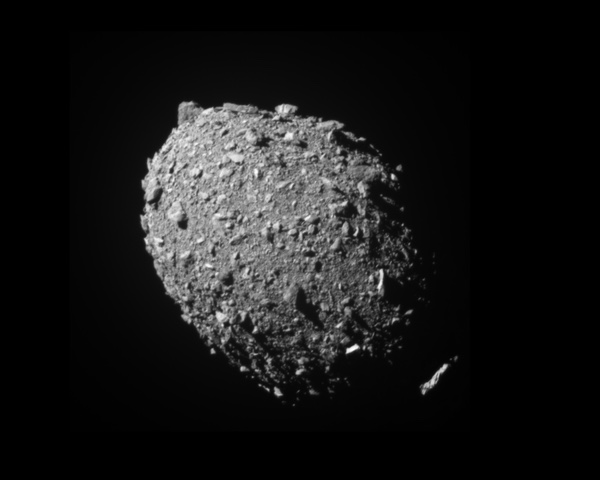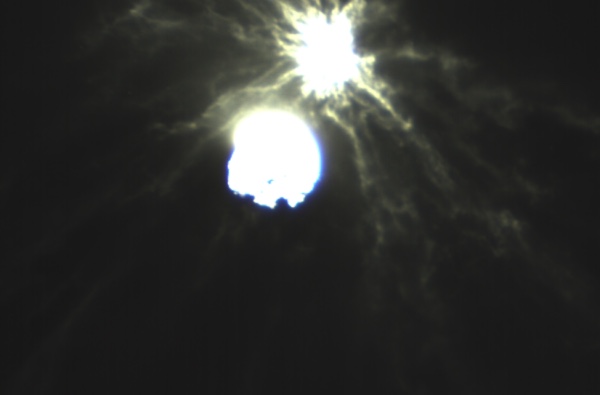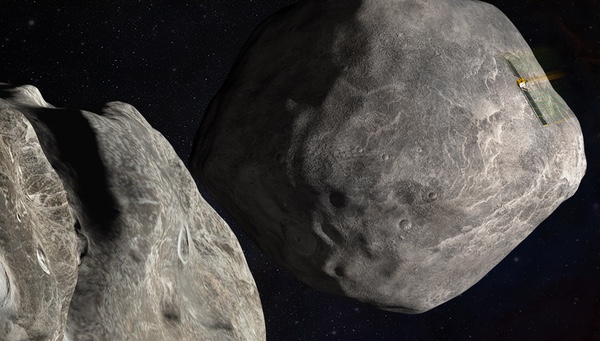Applied planetary science: DART’s bullseyeby Jeff Foust
|
| Because DART would be destroyed on impact, the best evidence of a successful collision would be a loss of signal: “one of the only times where a loss of signal is celebrated and cheered,” Congdon said. |
That launch attempt would have come less than 24 hours after the agency’s Double Asteroid Redirection Test (DART) mission reached its destination, the small asteroid Dimorphos that orbits the somewhat larger asteroid Didymos—and collided into it at 6.5 kilometers per second to test a way of changing the trajectory of a potentially hazardous asteroid. Had both gone according to schedule, there would have been some tough decisions for NASA officials, journalists, and others, regarding whether they should be at the Applied Physics Lab (APL) in Maryland for the DART impact or the Kennedy Space Center for the launch attempt (or both, although that would have pushed the limits of travel schedules.)
That doubleheader did not materialize. Concerns about Hurricane Ian led NASA to postpone the Artemis 1 launch. By Monday morning, hours before the DART impact, NASA announced it would move the SLS back to the Vehicle Assembly Building, delaying the launch to at least November.
Celestial mechanics, though, is not affected by hurricanes or hydrogen leaks. DART’s impact remained scheduled for 7:14 pm EDT on September 26, and there would be no scrubs or other delays, provided that the spacecraft was, in fact, able to hit Dimorphos, an object 160 meters across that the spacecraft’s camera would only be able to detect about an hour before impact.
At a briefing several days before impact, project officials expressed confidence DART would hit the target. Ed Reynolds, the project manager for DART at APL, said his primary concern was to make sure the team that would be in mission control for the impact was there on Monday, fully rested over the weekend and ready to go. “With all these rehearsals, with all these measurements, we’re in a very, very good place to do Monday’s event.”
“Through all the testing that we’ve done,” said Lindley Johnson, NASA’s planetary defense officer, at that briefing, “I’m highly confident that we’re going to hit on Monday and that it will be a complete success.”
The mission did prepare for 21 contingencies during DART’s final approach to Dimorphos. Some were minor, like adjusting camera settings on the spacecraft to improve the visibility of the asteroid, or telling the computer to switch targets if it confused Dimorphos with Didymos. The 21st, though, was a scenario where the spacecraft missed the asteroid entirely.
“If there is a miss, the first thing we have to do is figure out what happened,” Johnson said. “That will be the first thing: to safe the spacecraft, get all the information down from the spacecraft.” After understanding what went wrong, the mission team would regroup and look at alternative mission options, possibly using the NEXT-C electric propulsion system flown on the spacecraft as a technology demonstration.
| “We really had no idea what to expect,” said Adams. “All of us were kind of holding our breaths.” |
Those potential contingencies remained just that: potential. As crowds gathered at APL to hopefully celebrate an impact (media were there as well, but sequestered in another building far away from the celebration) DART closed in in Didymos and Dimorphos. About an hour out, as expected, DART’s camera, called DRACO, made out Dimorphos for the first time. The spacecraft autonomously locked on to Dimorphos using software called SMART Nav, based on technologies developed for missile defense applications.
Only in the final minutes did Dimorphos turn from a pixel in a DRACO image into an asteroid, with a rocky surface not unlike that seen on some other asteroids, like Bennu and Ryugu, suggesting immediately to planetary scientists that it might a “rubble pile” asteroid. (Project scientists previously said that, even if Dimorphos was a rubble pile, there was no chance that DART might punch its way through it: the rocks could not get out of the way fast enough.)
Because DART would be destroyed on impact, the best evidence of a successful collision would be a loss of signal: “one of the only times where a loss of signal is celebrated and cheered,” Betsy Congdon, mechanical lead engineer for DART, said in a talk about the mission at the International Astronautical Congress several days before impact. She added that the project team, in rehearsals in mission control, “even practiced cheering for the loss of signal.”
 The last image from DART showing all of Dimorphos, taken 11 seconds before impact. (credit: NASA/Johns Hopkins APL) |
At 7:14 pm EDT, as predicted, contact with DART was lost. The spacecraft was in the process of transmitting an image—DRACO was taking images at a rate of once per second as it approached Dimorphos—at the time of impact, so that final signal included a small part of a closeup of the impact point, cut off as the spacecraft hit the surface.
The mission team celebrated, although they didn’t say how close that real celebration was to the practiced one. At a press conference about 45 minutes after impact, they were clearly happy with how DART performed in those final moments.
“Forty minutes out, you were really getting a good feeling” about the impending impact, Reynolds said. Controllers monitored it closely up until the final minutes, when the window for sending any last-minute commands closed. At that point, he recalled, “it was just joy. You got to enjoy the moment.”
“We really had no idea what to expect,” Elena Adams, mission systems engineer for DART at APL, said. “All of us were kind of holding our breaths.”
Adams noted that the mission didn’t have to use any of the 21 contingencies it planned for. Their best initial estimate for the impact site was 17 meters from the center of Dimorphos: effectively a bullseye.
While the main mission of DART was a success, there were glitches elsewhere. During briefings in the hours leading up to the impact, NASA and APL officials said they fired the NEXT-C engine for only a couple hours early in the mission, stopping after noticing charging building up on the spacecraft.
“There’s some things we learned in burning that engine that basically made us tap the brakes a little bit,” said Thomas Zurbuchen, NASA associate administrator for science.
Bobby Braun, head of APL’s space exploration sector, said the engine itself performed as planned during the test, with the expected thrust and specific impulse. “In doing that, the team learned a secondary issue related to charging and grounding of the NEXT-C thruster that hadn’t previously seen in testing” on the ground, he said. “I’m confident we’ll see NEXT-C fly again.”
He added that while the spacecraft’s main solar array worked as designed, a small portion set aside as a “Transformational Solar Array” to test high-efficiency solar cells and concentrators did not, but didn’t elaborate on the problem. It did not affect the overall mission, and “that team has the data from this flight, and they’re going to learn and come back stronger.”
| “This demonstration is extremely important to our future on the Earth and life on Earth,” said Johnson. “It’s all part of our overall program, because planetary defense, frankly, is applied planetary science.” |
The DART spacecraft may have met its end, but the overall mission has not. Astronomers started almost immediately after impact to observe the Didymos-Dimorphos system, seeking to measure the change in the orbit of Dimorphos caused by the collision, which in turn will let scientists measure just how effective this “kinetic impactor” technique is for deflecting asteroids that, unlike Didymos and Dimorphos, pose a threat of hitting the Earth.
That process will likely take weeks. “I would be surprised if we had a firm measurement of the period change in less than a few days, and I would be really surprised if it took more than three weeks,” Tom Statler, DART program scientist at NASA, said before the impact.
 An image from the Italian cubesat LICIACube that captured the plume of the impact of DART with Dimorphos minutes after the impact. (credit: ASI/NASA) |
Images taken by groundbased telescopes, as well as the Hubble Space Telescope and James Webb Space Telescope, did show evidence of a large plume created by the impact. That was confirmed by LICIACube, a 6U cubesat provided by the Italian space agency ASI that was deployed from DART a few weeks before impact, flying by Dimorphos at a safe distance a few minutes after DART’s impact. Those images showed “streamers” and other structure in the plume from the impact that planetary scientists are studying.
Those observations will help refine models of asteroids and their structure. “It’s extremely helpful,” said Mallory DeCoster of APL, who worked on modeling of the impact. “Your models need validation with experimental data, even if you have just one data point to extrapolate to.”
That science, though, has a purpose: better preparing for a potential threatening asteroid. “This demonstration is extremely important to our future on the Earth and life on Earth,” said Johnson. “It’s all part of our overall program, because planetary defense, frankly, is applied planetary science.”
DART is supposed to be the first in a series of planetary defense missions, but the second, the Near Earth Object (NEO) Surveyor, is clouded in uncertainty. The mission was set to launch in 2026, carrying an infrared space telescope that will more efficiently search for NEOs than groundbased telescopes. NASA’s fiscal year 2023 budget proposal, though, slashed funding for the mission and pushed out its launch two years. House and Senate spending bills would partially restore funding, but not enough to avoid a delay. That cut came before the planetary science decadal survey, published in April, endorsed NEO Surveyor as part of the agency’s overall planetary defense strategy.
During a September 22 pre-impact briefing, Johnson noted that NEO Surveyor was going through its preliminary design review at the same time. “This is a big week for planetary defense,” he said.
However, he couldn’t say much about the schedule given the budget uncertainty. “Luckily, time is somewhat on our side in this business. An asteroid impact is an extremely rare event,” he said, referring to those large enough to be a concern. A two-year delay would not be a problem in the larger scheme of things, probably “Unless we happen to be particularly unlucky, I’m not worried about an impact in that kind of a timeframe.”
The results of DART are still pending, but Adams, the mission systems engineer, felt confident that this mission had supported that applied aspect of planetary science. “As far as we can tell, our first planetary defense test was a success,” she said at the post-impact briefing when asked if people should feel better about the ability to defend Earth from impacts. “Yes, I think Earthlings should sleep better. Definitely I will.”
Note: we are using a new commenting system, which may require you to create a new account.
